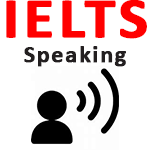
This is the IELTS with James information about the IELTS Speaking exam
The Speaking exam consists of three separate parts; Part 1, Part 2 and Part 3 and takes between 11 and 14 minutes to complete. Each exam is done on an individual basis, that is; one-to-one, and is NEVER performed in pairs or groups unless you’re doing the IELTS for UKVI. You do not need to bring anything with you to this exam, other than your brain, in order to complete it. During Part 2, which is also known as the “Individual long-turn”, you will be given a pencil/pen and some paper in order to write down your notes. Please be aware that all the exams are recorded. Don’t worry about this, it is so that the examiners can review a candidate if they want and also for the examiners themselves to be monitored to make sure they are doing their job correctly!!
The exam officially starts after you have sat down and the examiner says “Good Morning/Afternoon”. Before this, however, he will speak in the recorder and say the centre number, your name and candidate number as well as his/her name and examiner number. The examiner will then ask you your name and to see your ID so that they can check it against the details that they have for you. This is just a simple, further, security check, so don’t worry.
Once this is done, you will be asked “What should I call you?” Here, you can give them your English name or your Chinese name. It really doesn’t matter as the examiner will rarely use it anyway.

Part 1 – Introducing Yourself
4 – 5 Minutes
This is sometimes referred to as “The interview” because the examiner typically asks you questions to find out about you and your likes and dislikes, habits, culture etc. They are known as ‘Familiar’ topics. You should answer each question fully and use extended answers wherever possible. This part is a chance to introduce yourself, use vocabulary that is very common and well-known (My name is…. etc) in order to relax yourself and prepare for the rest of the exam.
Part 2 -The individual long turn
3 – 4 Minutes
In this part you are given a topic card that could be about anything (see the Part 2 examples in my app and on the website) and are given 1 minute to make some notes on what you want to say. Make sure that the moment you are given the topic card you start your notes or, if you have a question you ask it immediately. Once the time has started it will not stop. You must then speak for 1 to 2 minutes about the topic shown or until the examiner stops you. It is MUCH better if you can complete the 2 minutes!
Part 3 – The two-way discussion
4 – 5 minutes
This last section of the exam, although still being a question and answer session, can be looked at as more of a discussion between two people. The examiner will ask questions that are related to the topic card in part 2 and ask you for your opinion, thoughts and hypotheses and to identify things. Similarly to Part 1, you should also giving full sentences and extended answers.

Assessment
You are assessed in four categories; Fluency and Coherence, Lexical Resource (Vocabulary), Grammatical Range and Accuracy and Pronunciation. Each of these categories are marked between 0 and 9, with 0 being the lowest and 9 being the highest.
Mainly, this measures whether you hesitate or repeat yourself too much as well as whether what you say is ‘Coherent’, or in a logical order. The more you hesitate and repeat yourself, the lower your mark.
This measures the range of vocabulary you have and whether you can use less common words and idioms. If you use the same kinds of words for all your answers you won’t get a high score in this element.
In this part you are measured on the range of grammar you use. So, what this means is; do you use different types of sentence? Are they simple or complex? Are the tenses correct? etc. The more complex sentences you can use (and that are correct) the higher you score will be. That’s not to say you shouldn’t use some simple sentences too!
This section is measuring how you speak. Examiners are measuring you on the pronunciation of words as well as your emphasis or stress on some words, your intonation, your groupings and your speech rate.